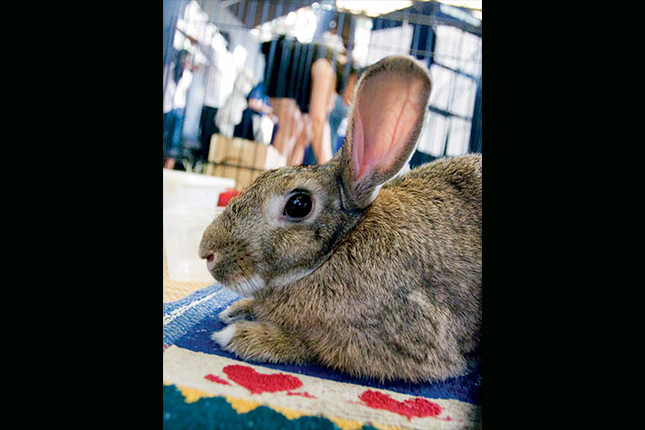Text and Images by Marcus Ng
BeMuse Volume 4 Issue 1 – Jan to Mar 2011
Smooth trickster, Easter herald, good luck charm and lunar companion. Far from being hare-brained, the rabbit in mythology enjoys a diversity of guises that mirrors the animals’ colonisation of every continent on Earth save Antarctica.

The Spring Festival, as the Lunar New Year is called in regions that enjoy a cycle of different seasons, is a time of utmost festivity as families and communities look forward to the end of winter and usher in a new annum of hope and progress. The festival also marks the onset of a fresh astrological year. Unlike the Western zodiac which determines one’s star sign based on the month of birth, the Chinese zodiac revolves around a twelve-year cycle in which an animal or shuxiang (属相) is assigned to each year. Traditionally, it is believed that the year of one’s birth influences his or her personality and behaviour, which would reflect in part the traits of the corresponding animal. Thus, an individual born in the Year of the Rabbit (1963, 1975, 1987, 1999, 2011) would tend to be gentle, gracious and intelligent though somewhat emotional, whereas those born under the Dragon are likely to be passionate, bold and quick-tempered.
The twelve animals that govern the Chinese zodiac are: Rat, Ox, Tiger, Rabbit, Dragon, Snake, Horse, Goat, Monkey, Rooster, Dog and Pig. Too ancient for its true origin to be traced, this sequence is sometimes attributed to Huang Di, the Yellow Emperor believed to have reigned more than 2,600 years before the common era (BCE) and said to be the father of the Chinese civilisation. Buddha (c. 563– 483 BCE) and Lao Tse (c. 604–531 BCE), the founder of Taoism, have also been credited, but what is known is that the Chinese zodiac has been in existence since the Eastern Han Dynasty (25–220 CE).
The most popular mythical account, however, credits the Jade Emperor of Heaven, who wanted to use animals to help people remember the years. He issued a decree that the first twelve creatures to report to him on the 30th day of the 12th month would be bestowed a year in their honour. The rabbit arrived after the tiger without incident, but what is often recounted is the drama between their earlier counterparts. The legend goes that the wily rat arrived first by riding on the ox while the latter forded a river. He then leapt off the ox’s back to reach the Jade Emperor’s palace before the weary bovine could do so. The easygoing ox was happy to forgive the rodent. But in his eagerness, the rat had forgotten to wake up his sleepy friend the cat, who thus missed the chance to have a year named after him. Thus, there is no Year of the Cat and a bitter enmity between the two species broke out as a result.
The rabbit returns later in the year when the Mid-Autumn Festival is celebrated. This festival, which falls on the 15th day of the eight lunar month, coincides with a period when the moon is at its brightest in the night sky, symbolising for many the joy of a whole family. Perhaps the best known story related to this festival is the tale of Chang Er, the wife of Hou Yi, an archer so keen-eyed he shot down nine suns that had threatened to scorch the earth with their heat. As a reward, the gods gave him an elixir of immortality. Unfortunately, Chang Er drank the brew by mistake while Hou Yi was out hunting and floated away until she reached the moon and became an immortal fairy. Keeping her company on the celestial body is a white rabbit who pounds herbs using a mortar and pestle. Meanwhile, Hou Yi remained devoted to his wife and laid out a table of offerings outside his house under the full moon to demonstrate his continual love.
The Mid-Autumn Festival is thought to have begun as people celebrated Hou Yi’s devotion as well as gathered their families around them in anticipation of the harvest season. The tradition of making and eating mooncakes arose in the Tang Dynasty (618–907 CE) and became popular as the shape of the confections symbolised the wholeness of the full moon (on which some claim to make out the shape of a hare) and the desire for a united family. During the late Ming Dynasty (1368–1644), the practice of worshipping Lord Rabbit or Tu’er Ye (兔儿爷) during the Mid-Autumn Festival emerged. From a simple animal pounding herbs, Lord Rabbit became a man-like figure with a rabbit’s head and wearing imperial armour and a golden helmet. With this dignified bearing, Lord Rabbit is often depicted riding a lion, a tiger, a deer or sitting on a lotus throne.
Given its nocturnal proclivities, the rabbit has become associated with the moon in other cultures as well. In ancient Egypt, hares (which are closely related to rabbits) were linked to the waxing and waning of the moon and the people of the city of Hermopolis worshipped a hare-headed goddess of fertility called Unut. According to a legend from India, Buddha, in the form of a hare, once travelled with an ape and a fox. The trio came across the god Indra in the guise of a hungry old man, who sought the animals’ hospitality. The ape and fox returned with food. Coming back empty-handed, the hare built a fire and flung himself into it to feed Indra, who rewarded this sacrifice by turning the animal into the Hare in the Moon.
In Celtic and Teutonic circles, Ostara or Eostre is the goddess of the moon, a huntress with an entourage of hares who often assumed the guise of a hare herself and is suspected to be the origin of the Easter Bunny tradition. Paying homage to the fortune and fecundity of rabbits, farmers or hunters during the Middle Ages uttered talismanic oaths to seek good luck in the fields and one such chant is thought to have evolved into an archaic nursery rhyme:
“Run rabbit run, rabbit run run run,
Run rabbit run, rabbit run run run,
Bang bang bang bang goes the farmer’s gun,
Run rabbit run, Rabbit run run run.
Run rabbit run, rabbit run run run,
Don’t give the farmer his fun fun fun,
He’ll get by without his rabbit pie,
So run rabbit run, rabbit run run run.”
With typical chutzpah, the British later adapted this rhyme during the Second World War, replacing ‘rabbit’ with ‘Adolf ’ to mock the Nazis’ attempts to conquer the British Isles. One place where warrens were unwelcome, however, is the Isle of Portland off Dorset, England, where the word ‘rabbit’ is taboo to locals, who regard it as a harbinger of misfortune. This superstition is said to have arisen in the 1920s when local quarry workers spotted rabbits emerging from a hole shortly before a rock fall and the animals were blamed for causing landslides by their burrowing.
Still, bunnies enjoy favourable press in most other places. The somewhat macabre Western tradition of carrying a rabbit’s foot in one’s pocket has multiple origin stories. One theory goes that catching a rabbit by the foot in a trap is a sign of further hunting success and so the foot was kept as a good luck charm. Another explanation stems from a medieval practice where alleged victims of witchcraft wore a rabbit’s foot around their necks at midnight under the full moon to ward off evil.
Curiously, witches were themselves often suspected to take on the form of a hare. English writer Walter de la Mare (1973–1956), on the other hand, paints a more benign encounter with a creature that straddles the realms of myth and magic in his poem The Hare:
In the black furrow of a field
I saw an old witch-hare this night;
And she cocked a lissome ear,
And she eyed the moon so bright,
And she nibbled of the green;
And I whispered “Whsst! witch-hare,”
Away like a ghostie o’er the field
She fled, and left the moonlight there.
In Aesop’s animal fables, the proud hare lost a race and won infamy for his complacency in taking a nap while the tortoise plodded on to snatch victory. Bunnies in other lores fare better, though. The Panchatantra is a collection of Sanskrit stories that convey moralistic lessons in a similar vein to the Greek storyteller. In one of the fables, a community of hares agree to sacrifice one member each day to a lion to prevent the beast from devouring them all at once. However, the chosen ‘victim’ manages to trick the lion into believing that his reflection in a well is another lion. Enraged by his ‘rival’, the lion leaps into the well to his death.
Tibetan and Burmese traditions also acknowledge the rabbit as a wily creature who pits brain against brawn. But lagomorphs (as rabbits and hares are known to zoologists) earn top billing in Native American folklore, where the cottontail rabbit is a trickster par excellence who outwits vastly more powerful foes. Both joker and bungler, the rabbit often falls victim to his own schemes, only to hop back to life none the wiser. A number of Native American tribes also perform a ritual known as the rabbit dance, in which dancers circle a drum and pretend to put food in their mouths while chewing like a rabbit as a mark of respect and request to the animal they are about to hunt. The rabbit is also a primeval force: Nanabozho the creator and benefactor, or the Great Hare who stole the sun for the people and gave the gift of fire.
West African tribes also revere the hare as a comic mastermind who gets other animals to perform his tasks. In one instance, the hare was too lazy to till his fields and so tied a rope to the hippopotamus and the elephant. The attempts by the two behemoths to get loose ultimately clear the hare’s fields and he was able to sow his crop. Converging on the North American continent as slaves from West Africa forcefully brought by colonists, these geographically disparate traditions of the rabbit as folk hero are thought to have given rise to the Brer Rabbit stories of America's Deep South.
In modern life, the rabbit pops up in rather more diverse iconography, from the streetwise Bugs Bunny to the risqué symbolism of the Playboy Mansion. Beatrix Potter forged an urbane landscape of tea-sipping bunnies with the Peter Rabbit books, while her compatriot Richard Adams turned a pastoral idyll into a realpolitik thriller in Watership Down, where warrens of rabbits are run along militaristic lines and wage bloody war. More innocent minds dream of Thumper, Bambi’s playmate in the woods, or the Velveteen Rabbit who became alive thanks to his devotion to a sick boy. One generation grew up wondering Who Framed Roger Rabbit, while their younger siblings laughed to the pest-control antics of Wallace and Gromit in The Curse of the Were-Rabbit. In culture and consciousness, the rabbit continues to lead men on a merry chase through fable and fantasy, and serve as a furry source for fascination and inspiration in ritual, religion and thumping good reads.
Hares and Rabbits: What’s The Difference?
Alice in Wonderland kicks off with a white rabbit who leads the heroine to a journey that ends up at a tea party presided by a Mad Hatter and a March Hare. Though usually regarded without distinction in most traditions, rabbits and hares are markedly different animals in the mammalian order Lagomorpha. The former are expert burrowers, preferring to hide from their predators, whereas hares, which have longer dark-tipped ears, never burrow, relying on their longer legs and ability to run up to 72 km/hour to flee from foes.
The European Rabbit (Oryctolagus cuniculus), which is native to Europe and has been introduced to Australia, where it is an agricultural pest, is the archetype of its group. But across the globe, there are more than 60 species of rabbits and hares. Most are found in temperate climates, but two endangered species, the Sumatran striped rabbit and Annamite striped rabbits, live in Sumatra’s highlands and Vietnam respectively.
Notes

















